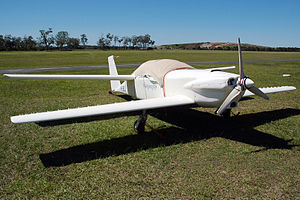Viking Dragonfly
| Dragonfly | |
|---|---|
 |
|
| Role | Light aircraft |
| National origin | United States of America |
| Manufacturer | Viking Aircraft LLC/Slipstream Industries |
| First flight | June 16, 1980 |
| Number built | 500+ (2003) |
| Unit cost |
US$8,500 (kit, 1998)
|
| Developed from | Rutan Quickie |
The Viking Dragonfly is an American amateur-built aircraft, designed by Bob Walters and produced by Viking Aircraft LLC of Elkhorn, Wisconsin. The aircraft is supplied as a kit or as plans for amateur construction.
The Dragonfly is a two-seater variant of the Rutan Quickie. The aircraft features a tandem wing layout with a forward wing mounted low and the other behind the cockpit in a shoulder position, a two-seats-in-side-by-side configuration enclosed cockpit under a bubble canopy, fixed landing gear and a single engine in tractor configuration. The cockpit is 43 in (109 cm) wide
The aircraft is made from composites. Its forward 20 ft (6.1 m) span wing employs a GU25-5(11)8 mod airfoil, when the aft wing (span 22 ft) uses an Eppler 1212 airfoil. Both wings have a total area of 92.2 sq ft (8.57 m2). Standard engines used include the 60 hp (45 kW) Volkswagen air-cooled engine and the 85 hp (63 kW) Jabiru 2200 four-stroke powerplants. Construction time from the supplied kit is estimated as 700 hours, while from plans is estimated at over 1200 hours.
The Dragonfly was given the Outstanding New Design Award at the EAA Convention in 1980. By 1998, 500 examples of all variants were reported as flying.
Data from
General characteristics
Performance
...
Wikipedia
